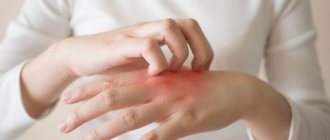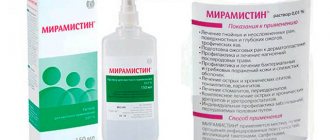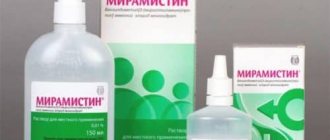Miramistin solution 0.01% 50 ml with gynecological attachment in Moscow
Locally. The drug is ready for use. Instructions for using packaging with spray nozzle.
- Remove the cap from the bottle; Also remove the urological applicator from the 50 ml bottle.
- Remove the supplied spray nozzle from its protective packaging.
- Attach the spray nozzle to the bottle.
- Activate the spray nozzle by pressing again.
Surgery, traumatology, combustiology. For preventive and therapeutic purposes, the surface of wounds and burns is irrigated, wounds and fistula tracts are loosely tamponed, gauze swabs soaked in the drug are fixed. The treatment procedure is repeated 2–3 times a day for 3–5 days. A highly effective method of active drainage of wounds and cavities with a daily consumption of up to 1 liter of the drug.
Obstetrics, gynecology. In order to prevent postpartum infection, it is used in the form of vaginal irrigation before childbirth (5–7 days), during childbirth after each vaginal examination and in the postpartum period, 50 ml of the drug in the form of a tampon with an exposure of 2 hours for 5 days. For the convenience of vaginal irrigation, it is recommended to use the gynecological nozzle included in the kit. When women give birth by cesarean section, the vagina is treated immediately before the operation, the uterine cavity and the incision on it are treated during the operation, and in the postoperative period, tampons soaked in the drug are inserted into the vagina with an exposure of 2 hours for 7 days. Treatment of inflammatory diseases is carried out over a course of 2 weeks by intravaginal administration of tampons with the drug, as well as by the method of medicinal electrophoresis.
Venereology. For the prevention of sexually transmitted diseases, the drug is effective if it is used no later than 2 hours after sexual intercourse. Using a urological applicator, insert the contents of the bottle into the urethra for 2-3 minutes: for men - 2-3 ml, for women - 1-2 ml and in the vagina - 5-10 ml. For convenience, the use of a gynecological attachment is recommended. Treat the skin of the inner thighs, pubis, and genitals. After the procedure, it is recommended not to urinate for 2 hours.
Urology. In the complex treatment of urethritis and urethroprostatitis, 2-3 ml of the drug is injected into the urethra 1-2 times a day, the course is 10 days.
Otorhinolaryngology. For purulent sinusitis, during puncture the maxillary sinus is washed with a sufficient amount of the drug. Tonsillitis, pharyngitis and laryngitis are treated by gargling and/or irrigation using a spray nozzle, pressing 3-4 times 3-4 times a day. The amount of drug per rinse is 10–15 ml.
Children. In case of acute pharyngitis and/or exacerbation of chronic tonsillitis, the pharynx is irrigated using a spray nozzle. At the age of 3-6 years - 3-5 ml per irrigation (press the head of the spray nozzle once) 3-4 times a day; 7–14 years — 5–7 ml per irrigation (press twice) 3–4 times a day; over 14 years old - 10-15 ml per irrigation (3-4 times pressing) 3-4 times a day. The duration of therapy ranges from 4 to 10 days, depending on the timing of remission.
Dentistry. For stomatitis, gingivitis, and periodontitis, it is recommended to rinse the mouth with 10–15 ml of the drug 3–4 times a day.
Miramistin gynecol nasad solution for local use 0.01% 50ml
Compound
Active substance: benzyldimethyl[3-(myristoyl-amino)propyl]ammonium chloride monohydrate (in terms of anhydrous substance) - 0.1 g.
Excipient: purified water - up to 1 liter.
Pharmacokinetics
When applied topically, Miramistin does not have the ability to be absorbed through the skin and mucous membranes.
Indications for use
For use in otorhinolaryngology:
- complex treatment of acute and chronic otitis, sinusitis, tonsillitis, laryngitis, pharyngitis;
- complex treatment of acute pharyngitis and/or exacerbation of chronic tonsillitis in children aged 3 to 14 years.
For use in dentistry:
- treatment and prevention of infectious and inflammatory diseases of the oral cavity: stomatitis, gingivitis, periodontitis, periodontitis;
- hygienic treatment of removable dentures.
For use in surgery and traumatology:
- prevention of suppuration and treatment of purulent wounds;
- treatment of purulent-inflammatory processes of the musculoskeletal system.
For use in obstetrics and gynecology:
- prevention and treatment of suppuration of postpartum injuries, wounds of the perineum and vagina, postpartum infections;
- prevention and treatment of inflammatory diseases (vulvovaginitis, endometritis).
For use in combustiology:
- treatment of superficial and deep burns of II and IIIA degrees;
- preparation of burn wounds for dermatoplasty.
For use in dermatology, venereology:
- treatment and prevention of pyoderma and dermatomycosis, candidiasis of the skin and mucous membranes, mycoses of the feet;
- individual prevention of sexually transmitted diseases (including syphilis, gonorrhea, chlamydia, trichomoniasis, genital herpes, genital candidiasis).
For use in urology:
- complex treatment of acute and chronic urethritis and urethroprostatitis of specific (chlamydia, trichomoniasis, gonorrhea) and nonspecific nature.
Contraindications
Hypersensitivity to the active substance.
The use of the drug in the form of a spray for irrigating the throat and tonsils is not recommended for children under 3 years of age due to the risk of reactive laryngospasm.
Directions for use and doses
The drug is ready for use.
Instructions for using the packaging with spray nozzle:
Remove the cap from the bottle and also remove the urological applicator from the 50 ml bottle.
Remove the supplied spray nozzle from its protective packaging.
Attach the spray nozzle to the bottle.
Activate the spray nozzle by pressing again.
Directions for using the 50 ml or 100 ml pack with gynecological attachment:
Remove the cap from the bottle.
Remove the supplied gynecological attachment from the protective packaging.
Attach the gynecological nozzle to the bottle without removing the urological applicator.
Directions for using 100 ml, 150 ml, 200 ml packaging with measuring cup:
To use the drug as a rinse, the amount of drug required for one rinse should be measured using the measuring cup included in the kit.
Otorhinolaryngology
Adults and children
For sinusitis: during puncture, the maxillary sinus is washed with a sufficient amount of Miramistin®.
For acute and chronic external otitis: up to 5 drops of the drug are instilled into the external auditory canal using a pipette 4 times a day or, instead of instillation, a gauze turunda soaked in the drug is carefully inserted into the external auditory canal 4 times a day. The course of treatment is 10 days.
Tonsillitis, pharyngitis, laryngitis:
Children 3-6 years old:
by pressing the head of the spray nozzle once or 3-5 ml per rinse, 3-4 times a day;
Children 7-14 years old:
pressing the head of the spray nozzle twice or 5-7 ml per rinse, 3-4 times a day;
Children over 14 years old and adults:
Press the head of the spray nozzle 3-4 times or 10-15 ml per rinse, 3-4 times a day.
The duration of therapy ranges from 4 to 10 days, depending on the timing of remission.
Dentistry
Adults and children
For stomatitis, gingivitis, periodontitis, it is recommended to rinse the mouth with 10-15 ml of the drug, 3-4 times a day. If rinsing is impossible, local use of gauze or cotton swabs moistened with a solution of Miramistin® is allowed.
Surgery, traumatology, combustiology
Adults and children
In order to treat and prevent secondary infection of wounds, the surface of the wound is irrigated with a solution of Miramistin®. Gauze swabs moistened with a solution of Miramistin® are fixed on the surface of the wound. If necessary, it is possible to pack the wound and/or fistula tracts during surgical procedures. Active drainage of wounds and/or cavities is possible. The daily consumption of Miramistin® is up to 1 liter of the drug.
Obstetrics, gynecology
Adults
Prevention and treatment of suppuration of postpartum injuries, wounds of the perineum and vagina, postpartum infections:
Miramistin® is used as vaginal irrigation before childbirth (5-7 days), during childbirth (after each vaginal examination). In the postpartum period, Miramistin® is administered using tampons soaked in 50 ml of the drug, with further exposure of the tampon for 2 hours for 5 days.
When women give birth by cesarean section, the vagina is treated immediately before the operation; during the operation
- the uterine cavity and an incision on it, and in the postoperative period, tampons soaked in Miramistin® are inserted into the vagina with an exposure of 2 hours for 7 days. Treatment of inflammatory diseases is carried out over a course of 2 weeks by intravaginal administration of tampons with the drug Miramistin®, as well as by the method of medicinal electrophoresis.
Complex treatment of inflammatory diseases in gynecology (vulvovaginitis):
in the form of vaginal irrigation or insertion of a tampon moistened with Miramistin®, with an exposure of 2 hours, for 7-14 days (the duration of treatment and the frequency of administration are determined as prescribed by the doctor). For the convenience of vaginal irrigation, the use of a gynecological nozzle is recommended. Insert the contents of the bottle into the vagina using a gynecological nozzle and perform irrigation.
Children
The method of application, duration of treatment and frequency of administration are determined as prescribed by the doctor.
Dermatology
Adults and children
Treatment and prevention of pyoderma and dermatomycosis, candidiasis of the skin and mucous membranes, mycoses of the feet: the drug Miramistin® is applied to the affected area of the skin by wiping with sterile gauze swabs, generously moistened with the drug. Miramistin® is used 3 times a day on the affected areas of the skin.
Venereology
Adults
Prevention of sexually transmitted diseases: the use of Miramistin® is effective within 2 hours after sexual intercourse. Using a urological applicator, insert the contents of the bottle into the urethra for 2-3 minutes:
Men:
2-3 ml of the drug;
Women:
Introduce 1-2 ml of the drug into the urethra and 5-10 ml into the vagina (for convenience, the use of a gynecological attachment is recommended).
Treat the skin of the inner thighs, pubis, and genitals.
After the procedure, it is recommended not to urinate for 2 hours.
Urology
Adults
In the complex treatment of urethritis and urethroprostatitis, 2-3 ml of the drug Miramistin® is injected into the urethra 1-2 times a day, the course is 10 days.
Children
The method of application, duration of treatment and frequency of administration are determined as prescribed by the doctor.
If there is no improvement after treatment, or symptoms worsen, or new symptoms appear, you should consult your doctor. Use the drug only according to the method of use and in the doses indicated in the instructions.
Storage conditions
The drug should be stored out of the reach of children at a temperature not exceeding 25°C.
Best before date
3 years. Do not use the drug after the expiration date.
Description
Antiseptic.
Pharmacodynamics
Miramistin® has a wide spectrum of antimicrobial action, including hospital strains resistant to antibiotics.
The drug has a pronounced bactericidal effect against gram-positive (Staphylococcus spp., Streptococcus spp., including Streptococcus pneumoniae, and others), gram-negative (including Pseudomonas aeruginosa, Escherichia coli, Klebsiella spp.), aerobic and anaerobic bacteria defined as monocultures and microbial associations, including hospital strains with multidrug resistance to antibiotics.
It has an antifungal effect on ascomycetes of the genus Aspergillus and the genus Penicillium, yeast (including Rhodotorula rubra, Torulopsis glabrata) and yeast-like fungi (including Candida albicans, Candida tropicalis, Candida krusei, Pityrosporum orbiculare (Malassezia furfur)), dermatophytes (including Trichophyton rubrum, Trichophyton mentagrophytes, Trichophyton verrucosum, Trichophyton schoenleini, Trichophyton violacent, Epidermophyton Kaufmann-Wolf, Epidermophyton floccosum, Microsporum gypseum, Microsporum canis), as well as other pathogenic fungi, in the form of monocultures and microbial associations , including fungal microflora with resistance to chemotherapy drugs.
It has an antiviral effect and is active against complex viruses (herpes viruses, human immunodeficiency virus and others).
Miramistin® acts on pathogens of sexually transmitted diseases (including Chlamydia spp., Treponema spp., Trichomonas vaginalis, Neisseria gonorrhoeae).
Effectively prevents infection of wounds and burns. Activates regeneration processes. Stimulates protective reactions at the site of application, due to the activation of the absorption and digestive functions of phagocytes, potentiates the activity of the monocyte-macrophage system. It has pronounced hyperosmolar activity, as a result of which it stops wound and perifocal inflammation, absorbs purulent exudate, promoting the formation of a dry scab. Does not damage granulations and viable skin cells, does not inhibit marginal epithelialization.
Does not have a local irritant effect or allergenic properties.
Side effects
The frequency parameters of adverse reactions are defined as follows: very often (≥1/10); often (≥1/100, but <1/10); uncommon (≥1/1000, but <1/100); rare (≥1/10000, but <1/1000); very rare (<1/10000); frequency unknown (cannot be estimated from available data).
Very rare (<1/10000):
- a slight burning sensation that goes away on its own after 15-20 seconds and does not require discontinuation of the drug;
- allergic reactions.
If you experience the side effects listed in the instructions for medical use, or they get worse, or you notice any other effects not listed in the instructions, tell your doctor.
Use during pregnancy and breastfeeding
According to available data, the use of the drug during pregnancy and breastfeeding is possible, because the drug does not have a systemic effect when used in accordance with the instructions, but remains at the discretion of the doctor.
Interaction
When used simultaneously with antibiotics, an increase in their antibacterial and antifungal properties was noted.
Overdose
There have been no cases of drug overdose with local or external use.
Miramistin instructions for use
Depending on the type of problem, there are several dosage regimens. For sinusitis and other lesions of the mucous membranes of the nasal cavity, rinse with a sufficient amount of solution.
Infectious diseases of the upper respiratory tract, such as tonsillitis, pharyngitis, laryngitis, are treated by spraying the inflamed areas using a spray nozzle. If it is not available, Miramistin can be used as a rinse. Swallowing the solution is unacceptable!
Deep wounds, as well as postoperative incisions and sutures are treated with Miramistin. If the injury requires regular dressings, then after removing the insulating material, the wound is washed with Miramistin solution, generously spilling the surface around the wound. If it is necessary to tamponate fistulas and deep violations of tissue integrity, gauze pads are generously impregnated with Miramistin and placed inside the wound, securing the top with a bandage.
Stomatitis and gingivitis require rinsing the mouth or copious spraying. When rinsing, I use 15 ml of product per procedure. Repeat the treatment of the oral cavity 3-4 times a day. It is important after irrigation with Miramistin not to eat or drink for 30-40 minutes so that the product is not washed off from the mucous membranes. This will speed up your recovery.
For gynecological diseases, bottles equipped with special attachments are used. The nozzle of the sprayer is inserted into the vagina and 3-4 presses are made so that the product is evenly distributed over the entire surface of the mucous membranes. If the expectant mother is about to give birth by cesarean section, the suture site must be treated with Miramistin, as well as the vagina. After the incision, the product is used to treat the uterine cavity and the incision itself. Further toileting of the genital organs involves wearing tampons soaked in Miramistin for 2 hours. The duration of such treatment is 7 days, which minimizes the risk of repeated infections.
After unprotected sexual intercourse, Miramistin can be effective if used no later than within the first 2 hours. In this case, a urological nozzle is used to introduce the drug into the urethra and hold it for 2-3 minutes. The product is injected into the vagina using another nozzle. It is recommended to take a horizontal position after irrigation and allow the product to be on the mucous membranes without leaking. At the same time, apply the solution to the pubis, inner thighs and genitals. After treatment, it is recommended not to empty your bladder for 2 hours.








